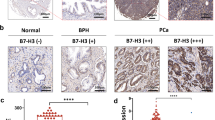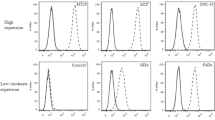Abstract
Purpose
Wide-field surgical excision reduces the chance of residual disease, but can also lead to disfigurement and devastating morbidities when resection is close to critical structures. We hypothesize that near-infrared fluorescence (NIRF) imaging can enable accurate detection of tumor margins for image-guided resection.
Experimental Design
An orthotopic model of human prostate cancer (PCa) was used to assess primary tumor margins using a NIRF-labeled antibody against epithelial cell adhesion molecule (EpCAM). PCa cells stably expressing far red fluorescent gene reporter, iRFP, enabled colocalization with NIRF signals for direct assessment of tumor margins.
Results
Using receiver operating characteristic analysis, far red fluorescence was validated against standard pathology of primary and metastatic lesions with >96 % accuracy. Primary tumor margins were more accurately detected by quantitative NIRF imaging using the EpCAM-targeting antibody as compared to a NIRF-labeled isotype control antibody.
Conclusions
NIRF molecular imaging may enable real-time and accurate assessment of tumor margins.





Similar content being viewed by others
References
Lovrics PJ, Cornacchi SD, Vora R, Goldsmith CH, Kahnamoui K (2011) Systematic review of radioguided surgery for non-palpable breast cancer. Eur J Surg Oncol (EJSO) 37:388–397
Atkins J, Mushawah FA, Appleton CM et al (2012) Positive margin rates following breast-conserving surgery for stage I–III breast cancer: palpable versus nonpalpable tumors. J Surg Res 117:109–115
Iczkowski KA, Lucia MS (2011) Frequency of positive surgical margin at prostatectomy and its effect on patient outcome. Prostate Cancer 2011:1–12
Swindle P, Eastham JA, Ohori M et al (2005) Do margins matter? The prognostic significance of positive surgical margins in radical prostatectomy specimens. J Urol 174:903–907
Philip AF, Ahmed MM (2013) Reporting positive surgical margins after radical prostatectomy: time for standardization. BJU Int. doi:10.1111/j.1464-410X.2012.11640.x
Kennedy MD, Jallad KN, Thompson DH, Ben-Amotz D, Low PS (2003) Optical imaging of metastatic tumors using a folate-targeted fluorescent probe. J Biomed Opt 8:636–641
Backer MV, Levashova Z, Patel V et al (2007) Molecular imaging of VEGF receptors in angiogenic vasculature with single-chain VEGF-based probes. Nat Med 13:504–509
Lee SB, Hassan M, Fisher R et al (2008) Affibody molecules for in vivo characterization of HER2-positive tumors by near-infrared imaging. Clin Cancer Res 14:3840–3849
Ogawa M, Kosaka N, Longmire MR, Urano Y, Choyke PL, Kobayashi H (2009) Fluorophore-quencher based activatable targeted optical probes for detecting in vivo cancer metastases. Mol Pharm 6:386–395
Jiang T, Olson ES, Nguyen QT, Roy M, Jennings PA, Tsien RY (2004) Tumor imaging by means of proteolytic activation of cell-penetrating peptides. Proc Natl Acad Sci U S A 101:17867–17872
van Dam GM, Themelis G, Crane LMA et al (2011) Intraoperative tumor-specific fluorescence imaging in ovarian cancer by folate receptor-[alpha] targeting: first in-human results. Nat Med 17:1315–1319
Valdės PA, Leblond F, Jacobs VL, Wilson BC, Paulsen KD, Roberts DW (2012) Quantitative, spectrally-resolved intraoperative fluorescence imaging. Sci Rep 2:798
Hall MA, Pinkston KL, Wilganowski N et al (2012) Comparison of mAbs targeting epithelial cell adhesion molecule for the detection of prostate cancer lymph node metastases with multimodal contrast agents: quantitative small-animal PET/CT and NIRF. J Nucl Med 53:1427–1437
Heath CH, Deep NL, Sweeny L, Zinn KR, Rosenthal EL (2012) Use of Panitumumab-IRDye800 to image microscopic head and neck cancer in an orthotopic surgical model. Ann Surg Oncol 19:3879–3887
Savariar EN, Felsen C, Nashi N et al (2013) Real time in vivo molecular detection of primary tumors and metastases with ratiometric activatable cell penetrating peptides. Cancer Res 73(2):855–864
Madajewski B, Judy B, Mouchli A et al (2012) Intraoperative near-infrared imaging of surgical wounds after tumor resections can detect residual disease. Clin Cancer Res 18:5741–5751
Nguyen QT, Olson ES, Aguilera TA et al (2010) Surgery with molecular fluorescence imaging using activatable cell-penetrating peptides decreases residual cancer and improves survival. Proc Natl Acad Sci 107:4317–4322
Day KE, Beck LN, Heath CH, Huang CC, Zinn KR, Rosenthal EL (2013) Identification of the optimal therapeutic antibody for fluorescent imaging of cutaneous squamous cell carcinoma. Cancer Biol Ther 14(3):271–277
Jain RK (1988) Transvascular and interstitial transport in tumors. Adv Exp Med Biol 242:215–220
Sevick-Muraca EM, Sharma R, Rasmussen JC et al (2008) Imaging of lymph flow in breast cancer patients after microdose administration of a near-infrared fluorophore: feasibility study. Radiology 246:734–741
Sevick-Muraca EM (2012) Translation of near-infrared fluorescence imaging technologies: emerging clinical applications. Annu Rev Med 63:217–231
Scheunemann P, Stoecklein NH, Hermann K et al (2009) Occult disseminated tumor cells in lymph nodes of patients with gastric carcinoma. A critical appraisal of assessment and relevance. Langenbeck's Arch Surg 394:105–113
Tveito S, Andersen K, Kåresen R, Fodstad Ø (2011) Analysis of EpCAM positive cells isolated from sentinel lymph nodes of breast cancer patients identifies subpopulations of cells with distinct transcription profiles. Breast Cancer Res 13:R75
Cimino A, Halushka M, Illei P, Wu X, Sukumar S, Argani P (2010) Epithelial cell adhesion molecule (EpCAM) is overexpressed in breast cancer metastases. Breast Cancer Res Treat 123:701–708
Zellweger T, Ninck C, Bloch M et al (2005) Expression patterns of potential therapeutic targets in prostate cancer. Int J Cancer 113:619–628
Shu X, Royant A, Lin MZ et al (2009) Mammalian expression of infrared fluorescent proteins engineered from a bacterial phytochrome. Science 324:804–807
Filonov GS, Piatkevich KD, Ting LM, Zhang J, Kim K, Verkhusha VV (2011) Bright and stable near-infrared fluorescent protein for in vivo imaging. Nat Biotechnol 29:757–761
Hall MA, Kwon S, Robinson H et al (2011) Imaging prostate cancer lymph node metastases with a multimodality contrast agent. Prostate 72:129–146
Gao P, Pinkston KL, Nallapareddy SR, van Hoof A, Murray BE, Harvey BR (2010) Enterococcus faecalis rnjB is required for pilin gene expression and biofilm formation. J Bacteriol 192:5489–5498
Hall MA, Aldrich MB, Azhdarinia A et al (2012) Quantifying multimodal contrast agent biological activity using near-infrared flow cytometry. Contrast Media Molec Imaging 7:338–345
Zhu B, Rasmussen JC, Lu Y, Sevick-Muraca EM (2010) Reduction of excitation light leakage to improve near-infrared fluorescence imaging for tissue surface and deep tissue imaging. Med Phys 37:5961–5970
Zhu B, Tan IC, Rasmussen JC, Sevick-Muraca EM (2012) Validating the sensitivity and performance of near-infrared fluorescence imaging and tomography devices using a novel solid phantom and measurement approach. Technol Cancer Res Treat 11:95–104
Sevick-Muraca EM, Zhu B (2013) The need for performance standards in clinical translation and adoption of fluorescence molecular imaging. Medical physics 40:040402-1-2
Murthy K, Aznar M, Thompson CJ, Loutfi A, Lisbona R, Gagnon JH (2000) Results of preliminary clinical trials of the positron emission mammography system PEM-I: a dedicated breast imaging system producing glucose metabolic images using FDG. J Nucl Med 41:1851–1858
Prabhakar U, Blakey DC, Maeda H, et al. (2013) Challenges and key considerations of the enhanced permeability and retention effect (EPR) for nanomedicine drug delivery in oncology. Cancer Research. doi:10.1158/0008-5472.CAN-12-4561
Acknowledgments
This research is supported in parts by the Wilson Foundation of Dallas Texas and U54 CA136404 (EMS). We thank Dr. Ron Karni for his critical comments.
Conflict of Interest
The authors declare to have no conflict of interest.
Author information
Authors and Affiliations
Corresponding author
Rights and permissions
About this article
Cite this article
Zhu, B., Wu, G., Robinson, H. et al. Tumor Margin Detection Using Quantitative NIRF Molecular Imaging Targeting EpCAM Validated by Far Red Gene Reporter iRFP. Mol Imaging Biol 15, 560–568 (2013). https://doi.org/10.1007/s11307-013-0637-8
Published:
Issue Date:
DOI: https://doi.org/10.1007/s11307-013-0637-8




